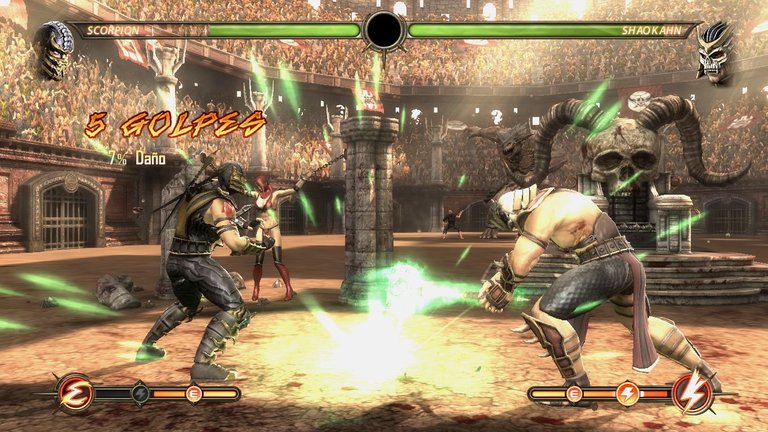

Mortal Kombat is a pretty weird franchise as history goes about, finding incredible success at its first entry due to the digitized graphics with extreme violence through the now-iconic Fatalities attracted many people around the world to both love and hate the game (as you might have heard about how controversial it was and being the main reason behind ESRB's existence today), the first two sequels and Trilogy making even more money and noise around the world...and then having a dive starting Mortal Kombat 4 and onwards, as while the Deadly Alliance/Deception/Armageddon trilogy helped keep a bit of relevance on the people as that era was notoriously short of fighting games, most of their games since MKT had problems with technical experience or development issues which delivered underwhelming or even outright broken games...
However, as Midway went under in 2009, Warner Bros. bought all of their assets (including Tthe Mortal Kombat IP), and after a long slumber filled with so much divisive and bad games, Mortal Kombat finally made a triumphant return in 2011...and it meant business. After MKvsDC being such a flop in everything, this game showed that these Kombats weren't messing around anymore, retconning all the previously seen story and returning to the plotline from the first three games, and the presentation was much more serious and solid than anything the Earthrealm kombatants ever had been seen before.
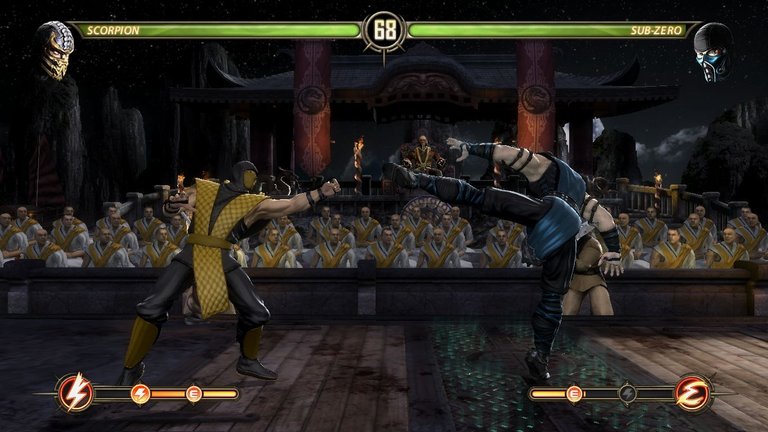
This game emphasized on a much more realistic yet relatively stylized artstyle, a grim and subtle palette of colors, and places that made justice to how desolate and horriffic the world on Mortal Kombat was intended to be since the first games, all thanks to a visibly higher amount of expertise with visual design and better usage of the power that the PS3, Xbox 360 and PCs (at the time) could provide. It became even more apparent when you could actually, visibly see the damage on fighters with torn off skin and blood when fighting, the X-Ray moves that showed your opponent's skeleton and organs getting cracked (hence "X-Ray"), and of course, the fatalities, which here they really took advantage of the new graphics. To put it simple, this Mortal Kombat makes you feel the same way how every kid and dude likely felt after watching the first games in the 90s. And knowing how this was a "return-to-roots" game, they definitely achieved what they were looking for.
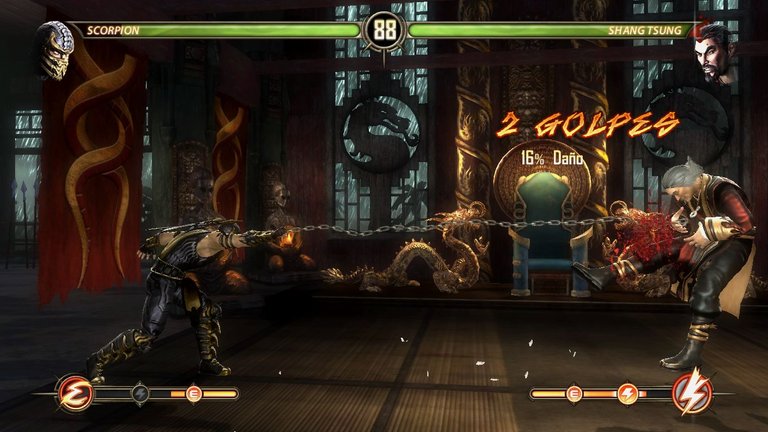
However, another big highlight on top of how the game managed to look so "Mortal Kombat", was the gameplay, which is on a 2.5D plane and pretty much took almost every cue from the classic Mortal Kombat controls and gameplay (2 punch buttons, 2 kick buttons and a guard button), but with several additions and enhancements to fit into the modern era of games, like having a Grab button, basic moves being much more different between other characters, breakers (which works like a parry, as guarding at the right time whileh holding forward pushes away the opponent without getting damaged yourself), and the addition of a bar which allows using enhanced special moves and the X-Ray, which is pretty much a super move that inflicts a lot of damage and, as I mentioned before, gives you the sight of your opponent's bones getting damaged as you strike them.
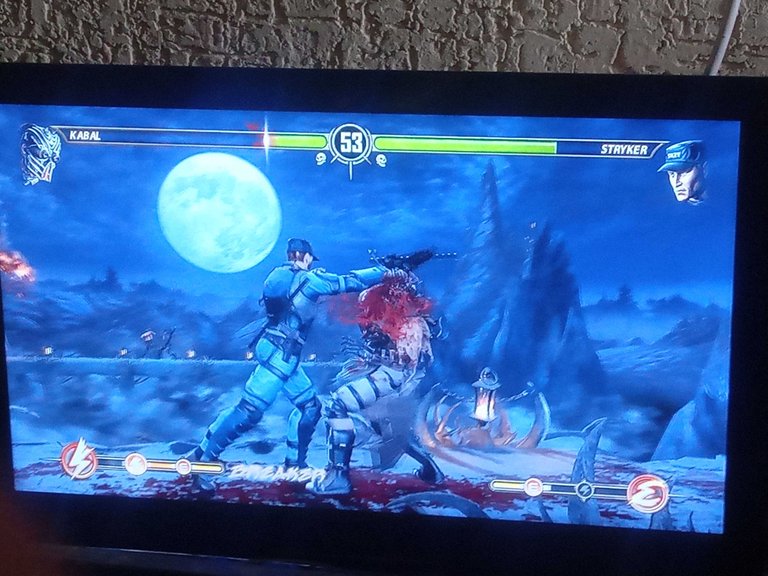
It takes cues from the classic MK trilogy for stages, ideas and even costumes, as some characters have their classic costumes from back then, but for the most part, it does a very good job of making something new yet familiar from the old material, which includes the gameplay being a more approachable and modern version of classic MK gameplay with capitalizing on juggles, using your basic attacks, and using the short but useful button strings for attacks. It really feels good to play wth the bigger variety of moves and the sound design making each hit feel even stronger, and the best part is that, on top of the surprising amount of single player content (including a Story mode, as well as the classic arcade mode where you face Shao Kahn at the end, as cheap as always), it is a total blast to play with friends, as I also played this quite a lot the day of my birthday with some buddies :)
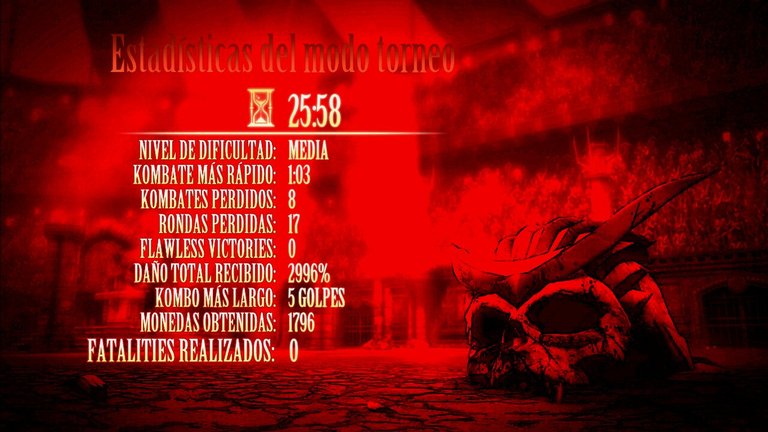

Spanish translation with DeepL. All screenshots were captured by myself.
Español
Mortal Kombat es una franquicia bastante extraña en lo que respecta a la historia, encontrando un éxito increíble en su primera entrada debido a los gráficos digitalizados con violencia extrema a través de los ahora icónicos Fatalities que atrajeron a mucha gente de todo el mundo tanto a amar como a odiar el juego (como habrás oído acerca de lo controvertido que era y siendo la razón principal detrás de la existencia de ESRB hoy en día), las dos primeras secuelas y la Trilogía haciendo aún más dinero y ruido en todo el mundo. ...y luego teniendo una caída en picado a partir de Mortal Kombat 4 y en adelante, ya que si bien la trilogía Deadly Alliance/Deception/Armageddon ayudó a mantener un poco de relevancia en la gente ya que esa época era notoriamente escasa en juegos de lucha, la mayoría de sus juegos desde MKT tuvieron problemas de experiencia técnica o problemas de desarrollo que entregaron juegos decepcionantes o incluso directamente rotos...
Sin embargo, cuando Midway se hundió en 2009, Warner Bros. compró todos sus activos (incluyendo la IP de Mortal Kombat), y después de un largo letargo lleno de juegos malos y divisivos, Mortal Kombat finalmente hizo un regreso triunfal en 2011... y lo hizo en serio. Después de que MKvsDC fuera un fracaso en todo, este juego demostró que estos Kombat ya no se andaban con chiquitas, reconvirtiendo toda la historia vista anteriormente y volviendo a la línea argumental de los tres primeros juegos, y la presentación fue mucho más seria y sólida que todo lo que se había visto antes de los kombatantes de Earthrealm.

Este juego hacía hincapié en un estilo artístico mucho más realista pero relativamente estilizado, una paleta de colores sombría y sutil, y lugares que hacían justicia a lo desolado y horrible que pretendía ser el mundo de Mortal Kombat desde los primeros juegos, todo ello gracias a una experiencia visiblemente mayor en el diseño visual y a un mejor uso de la potencia que podían ofrecer la PS3, la Xbox 360 y los PC (en aquel momento). Se hizo aún más evidente cuando se podía ver el daño en los luchadores con la piel arrancada y la sangre al luchar, los movimientos de rayos X que mostraban el esqueleto y los órganos de tu oponente agrietándose (de ahí lo de "rayos X"), y por supuesto, los fatalities, que aquí sí que aprovecharon los nuevos gráficos. En pocas palabras, este Mortal Kombat te hace sentir lo mismo que todos los niños y los chicos sintieron después de ver los primeros juegos en los 90. Y sabiendo que este fue un juego de "regreso a las raíces", definitivamente lograron lo que buscaban.

Sin embargo, otro gran punto a destacar además de cómo el juego logró lucir tan "Mortal Kombat", fue la jugabilidad, que está en un plano 2. 5D y que prácticamente tomó todas las referencias de los controles y la jugabilidad del Mortal Kombat clásico (2 botones de puñetazo, 2 botones de patada y un botón de guardia), pero con varias adiciones y mejoras para adaptarse a la era moderna de los juegos, como tener un botón de agarre, movimientos básicos mucho más diferentes entre otros personajes, rompedores (que funciona como un parry, ya que al hacer la guardia en el momento adecuado mientras mantienes el avance alejas al oponente sin recibir daño tú mismo), y la adición de una barra que permite usar movimientos especiales mejorados y el X-Ray, que es prácticamente un supermovimiento que inflige mucho daño y, como he mencionado antes, te permite ver cómo se dañan los huesos de tu oponente mientras lo golpeas.

Toma referencias de la trilogía clásica de MK en cuanto a escenarios, ideas e incluso trajes, ya que algunos personajes tienen sus trajes clásicos de entonces, pero en su mayor parte, hace un muy buen trabajo de hacer algo nuevo y a la vez familiar a partir del material antiguo, lo que incluye que la jugabilidad sea una versión más accesible y moderna del juego clásico de MK con la capitalización de los malabares, el uso de tus ataques básicos y el uso de las cortas pero útiles cadenas de botones para los ataques. Es muy agradable jugar con la mayor variedad de movimientos y el diseño de sonido que hace que cada golpe se sienta aún más fuerte, y lo mejor es que, además de la sorprendente cantidad de contenido para un jugador (incluyendo un modo Historia, así como el clásico modo arcade en el que te enfrentas a Shao Kahn al final, tan barato como siempre), es una explosión total para jugar con amigos, ya que también lo jugué bastante el día de mi cumpleaños con algunos amigos :)


Traducción al español hecha con DeepL. Todas las fotos capturadas por mí.